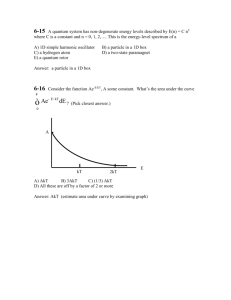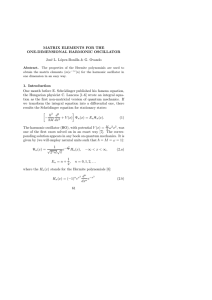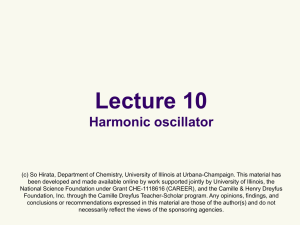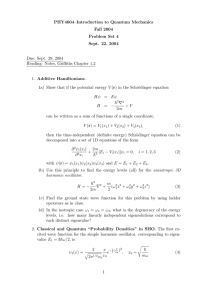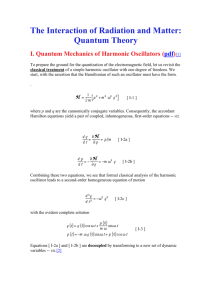Introduction to computational quantum mechanics Lecture 7: Simen Kvaal
advertisement
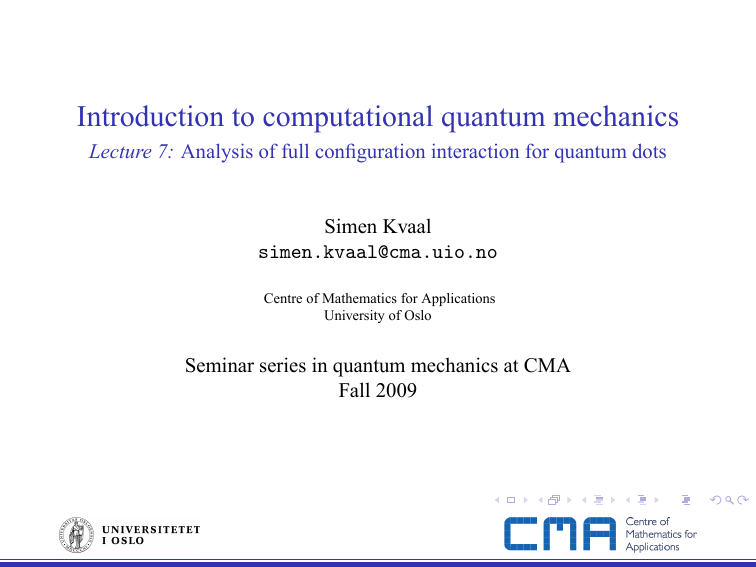
Introduction to computational quantum mechanics
Lecture 7: Analysis of full configuration interaction for quantum dots
Simen Kvaal
simen.kvaal@cma.uio.no
Centre of Mathematics for Applications
University of Oslo
Seminar series in quantum mechanics at CMA
Fall 2009
Outline
Setting
Full configuration interaction
The harmonic oscillator
Model space and approximation
Numerical results
Quantum dots
No-core shell model calculations
References
Outline
Setting
Full configuration interaction
The harmonic oscillator
Model space and approximation
Numerical results
Quantum dots
No-core shell model calculations
References
Quantum dots
In this lecture, we will consider so-called quantum dots: nanoscale,
fabricated devices that can confine a number N of electrons.
Figure: Micrograph of a fabricated “triple quantum dot”. Electrical leads confine
electrons in a potential roughly equal to three harmonic oscillators glued together
Hamiltonian, Hilbert-space and basis
We consider here parabolic quantum dots, where the electrons are confined
in a ideal harmonic oscillator potential
I We consider N particles in d dimensions with spin 1 , i.e., S = {↑, ↓}:
2
H = Π− L2 (Rd × S)⊗N
I
The Hamiltonian H is given by
N
H=
∑ H0,k + λ ∑
k=1
I
Vij
(ij), i6=j
Here H0 is the harmonic oscillator,
1
1
H0 = − ∇2 + k~rk2 ,
2
2
and
Vij =
1
k~ri −~rj k
but other (nicer) interactions are possible as well.
Spectrum of Hamiltonian
N
1 2 1
2
H = ∑ − ∇i + k~rk + λ ∑ Vij
2
2
i=1
(ij), i6=j
Theorem (Spectrum)
The spectrum σ(H) of the parabolic quantum dot is purely discrete.
Outline
Setting
Full configuration interaction
The harmonic oscillator
Model space and approximation
Numerical results
Quantum dots
No-core shell model calculations
References
Full configuration interaction (FCI)
I
I
In one sentence: Rayleigh-Ritz-Galerkin method for the eigenvalues of
H, using Slater determinant basis functions with one-particle
eigenfunctions of H0 as orbitals.
Gives a standard matrix eigenvalue problem Hu = Eu for a fixed
number of basis functions ΦSD
i , where
SD
Hij = hΦSD
i , HΦj i
I
I
Convergence of this approach (as the matrix dimension grows) was
established in Lecture 5.
But: How fast does the method converge as the basis grows? Can we
say saomething of the error in the discrete eigenvalues?
More on H
To answer these questions, we begin with some properties of H:
Theorem (Properties of H)
Define A by
N 1
1
1
1
A = ∑ − ∇2i + k~ri k2 = − ∇2ξ + kξk2 ,
2
2
2
2
i=1
with ξ = (~r1 , · · · ,~rN ) ∈ RNd , and define also
V = ∑ Vij .
(ij)
Thus H = A + λV.
Now, A and H + c are positive definite for some constant c, and V is
relatively bounded by A, meaning that the norms kψkA = hψ, Aψi and
kψkH+c = hψ, (H + c)ψi are equivalent.
Convergence result of Ritz-Galerkin
Using the previous facts, standard results on Ritz-Galerkin imply that:
Theorem (Error of Ritz-Galerkin)
Suppose E is a simple eigenvalue of H, with eigenvector ψ, and that
M ⊂ D(H) ⊂ H is a linear subspace with orthogonal projector P. Suppose
Eh ∈ σ(PHP) = σ(H) is the Ritz-Galerkin approximation to E. Then there is
a constant C1 such that
0 ≤ Eh − E ≤ C1 k(1 − P)ψk2A ,
where 1 − P is the orthogonal projector onto M ⊥ . Moreover, there is a
constant C2 such that
0 ≤ kψh − ψk ≤ C2 k(1 − P)ψkA .
We need to estimate k(1 − P)ψkA , i.e., to study how well M can
approximate ψ. Crucial to this is the study of the harmonic oscillator
eigenfunctions.
Outline
Setting
Full configuration interaction
The harmonic oscillator
Model space and approximation
Numerical results
Quantum dots
No-core shell model calculations
References
The one-particle orbitals
I
I
The Slater determinants are created from the eigenfunctions φn ∈ H1 of
H0 .
These are called d-dimensional Hermite functions and are of the form:
φn (~r) = hn1 (r1 )hn2 (r2 ) · · · hnd (rd ),
n = (n1 , · · · , nd )
where the standard Hermite functions are given by:
hn (x) = [π1/2 2n n!]−1/2 Hn (x)e−x
I
I
2 /2
,
n = 0, 1, 2, · · ·
The hn (x) are eigenfunctions of (−∂2 /∂x2 + x2 )/2 with eigenvalue
n + 1/2.
The eigenvalue of φn is
n = n1 + n2 + · · · + nd +
d
2
which is in general a multiple eigenvalue (“degenerate”)
Plot of the standard Hermite functions
The first 50 Hermite functions
60
50
40
30
20
10
0
−15
−10
−5
0
5
10
15
Figure: The 50 first Hermite functions hn (x), shifted vertically according to their
harmonic oscillator eigenvalue. Notice that the oscillations gets narrower with higher
n, while the region of oscillation gets wider. Notice also the Gaussian tail.
Two-dimensional (d = 2) Hermite functions
n = (0,0)
0.8
−10
0.6
−8
−6
0.4
−4
0.2
−2
0
0
2
−0.2
4
−0.4
6
8
−0.6
10
−10
−5
0
5
10
−0.8
Two-dimensional (d = 2) Hermite functions
n = (1,4)
0.8
−10
0.6
−8
−6
0.4
−4
0.2
−2
0
0
2
−0.2
4
−0.4
6
8
−0.6
10
−10
−5
0
5
10
−0.8
Two-dimensional (d = 2) Hermite functions
n = (4,1) + n = (1,4)
0.8
−10
0.6
−8
−6
0.4
−4
0.2
−2
0
0
2
−0.2
4
−0.4
6
8
−0.6
10
−10
−5
0
5
10
−0.8
Two-dimensional (d = 2) Hermite functions
n = (13,22)
0.8
−10
0.6
−8
−6
0.4
−4
0.2
−2
0
0
2
−0.2
4
−0.4
6
8
−0.6
10
−10
−5
0
5
10
−0.8
Outline
Setting
Full configuration interaction
The harmonic oscillator
Model space and approximation
Numerical results
Quantum dots
No-core shell model calculations
References
Slater determinants
The Slater determinants Φn1 ,··· ,nN , where now ni = (ni1 , · · · , nid ), built from
d-dimensional Hermite functions have the following properties:
I Eigenfunctions of A, which is in fact an Nd-dimensional Harmonic
oscillator
I For example, for N = 2 (ignoring spin for now):
1
Φn1 ,n2 (~r1 ,~r2 ) = √ [φn1 (~r1 )φn2 (~r2 ) − φn2 (~r1 )φn1 (~r2 )]
2
Note: Each term is a Nd-dimensional Hermite function, with same
eigenvalue of A
The model space M
We define a cut parameter R and a sequence of projectors PR onto spaces
MR such that MR ⊂ MR+1 , and PR → 1 as R → ∞.
I
I
Model space MR with basis BR :
BR := Φn1 ···nN : n1 + · · · + nN ≤ R
That is, the Slater determinants whose harmonic oscillator eigenvalue is
at most R + Nd/2.
This induces corresponding sequence of discrete problems:
Hh uh = Eh uh ,
I
h=
1
R
We have introduced the “mesh parameter h” as usual
Approximation properties of MR
The proof of the following theorem is very similar to the proof of decay of
Fourier series coefficients for smooth functions:
Theorem
Approximation by Hermite functions Assume ψ ∈ H k (Rn ), i.e., ψ is k times
weakly differentiable. Assume further that ψ decays exponentially, meaning
that for some µ > 0, ψ(ξ)eµkξk ∈ L2 .
Then:
k(1 − PR )ψk2A = O(R−γ ) = O(hγ ) for some γ ≥ k − 1.
The converse is also true: The asymptotic behaviour implies H k -smoothness,
assuming exponential decay.
Error estimate for eigenvalues
We then arrive at the following:
I Suppose we know that ψ ∈ H k for some k.
I Then,
Eh − E = O(R−γ )
I
Smoothness properties of ψ can be shown to be at least k = 1.
Scaling properties of FCI
1. Sparsity of the matrix H comes from
Slater-Condon rules and
orthonormality of orbitals.
2. However, number of nonzeroes is not
O(dim(MR )), but grows faster.
3. Suppose M is the total amount of
memory available. Then the best FCI
result goes like:
Eh − E ∼ [(Nd)!N!M]−γ/Nd
This is not very impressive. “Curse
of dimensionality!”
Figure: Typical structure of an
N = 3 matrix
Outline
Setting
Full configuration interaction
The harmonic oscillator
Model space and approximation
Numerical results
Quantum dots
No-core shell model calculations
References
Convergence of parabolic dot FCI
N is number of particles, R = Nmax , M is total angular momentum, S is total
electron spin. Curves show δE/E.
Relative error for N=2, λ = 2
1
10
M=0, S=1, α = −1.2772
M=0, S=3, α = −2.1716
M=2, S=1, α = −1.3093
M=2, S=3, α = −2.5417
M=0, S=0, α = −1.0477
0
10
M=0, S=2, α = −2.1244
M=3, S=0, α = −3.1749
−1
−2
10
M=3, S=2, α = −4.0188
Relative error
10
Relative error
Relative error for N=3, λ=2
−1
10
−2
10
−3
10
−3
10
−4
10
−4
10
−5
10
−6
10
−5
6
8
10
12
R
14
16
18
20
10
6
8
10
12
R
14
16
18
20
Convergence of parabolic dot FCI
N is number of particles, R = Nmax , M is total angular momentum, S is total
electron spin. Curves show δE/E.
Relative error for N=4, λ = 2
−1
Relative error for N=5, λ = 0.2
−2
10
10
M=0, S=0, α = −1.4233
M=0, S=4, α = −2.8023
M=3, S=2, α = −1.5327
M=3, S=4, α = −3.2109
−2
10
M=0, S=1, α = −1.5150
M=0, S=5, α = −3.6563
M=3, S=1, α = −1.8159
M=3, S=5, α = −4.2117
−3
Relative error
Relative error
10
−3
10
−4
10
−4
10
6
8
10
12
R
14
16
18
20
6
8
10
12
R
14
16
18
20
Exponential convergence in NCSM calculations
log(|E − Efadd |)
102
100
10−2
0
10
20
30
40
N
h̄ω = 24 MeV, |E − Efadd | ∼ Ce−0.15N
From Navratil & Barrett, PRC 57, p. 562
(1998). Convergence test of NCSM for
3 H, Nijmegen II effective interaction.
Outline
Setting
Full configuration interaction
The harmonic oscillator
Model space and approximation
Numerical results
Quantum dots
No-core shell model calculations
References
References
S.K.
Analysis of many-body methods for quantum dots
PhD thesis
2009
Babuska, I. and Osborn, J.E.
Finite Element-Galerkin Approximation of the Eigenvalues and
Eigenvectors of Selfadjoint Problems
Math. Comp. 52, pp. 275–297
1989

